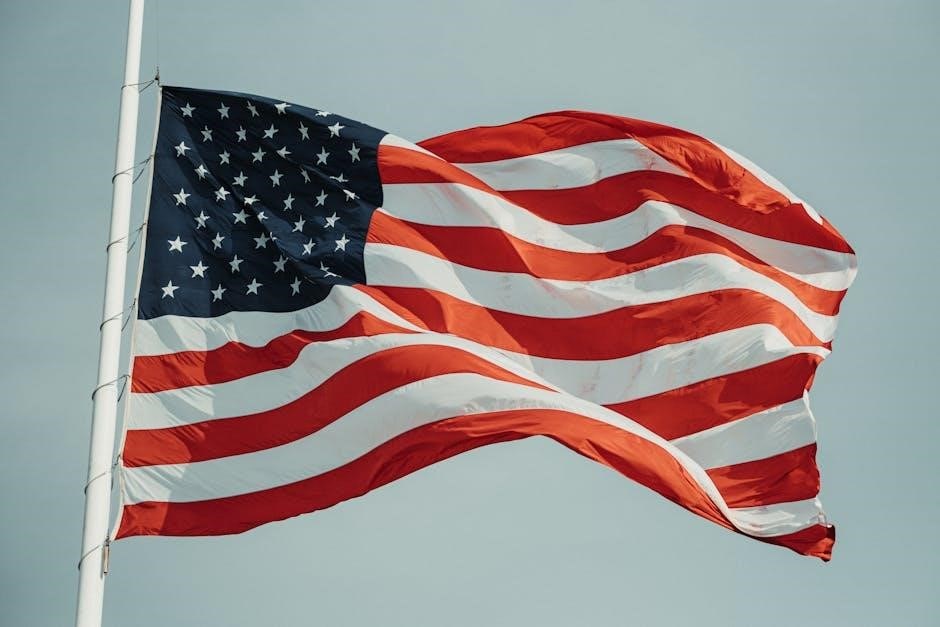stars and stripes forever pdf

The Stars and Stripes Forever, composed by John Philip Sousa in 1896, is a iconic patriotic American march. It holds the title of the official National March of the United States, symbolizing national pride and patriotism. The piece is widely performed at ceremonies and celebrations, with its grand melody and stirring rhythms evoking strong emotional responses. Available in various arrangements, including PDF formats for different ensembles, it remains a cornerstone of American musical heritage, celebrating the spirit of freedom and unity.
Overview of the Composition
The Stars and Stripes Forever, composed by John Philip Sousa in 1896, is a grand patriotic march that embodies the spirit of American nationalism. The piece is structured in a traditional march form, featuring a bold introduction, memorable themes, and a triumphant conclusion. One of its most distinctive features is the piccolo solo, which was originally written for the Db piccolo, a common instrument in bands during Sousa’s time. The composition is known for its dynamic contrasts, sweeping melodies, and rhythmic energy, all of which contribute to its enduring popularity. The march is often performed in various arrangements, including full band, orchestral, and chamber ensemble versions, with sheet music widely available in PDF formats for both professional and amateur musicians.
Historical Significance of the Piece
The Stars and Stripes Forever holds profound historical significance as a symbol of American patriotism and national identity. Composed by John Philip Sousa in 1896, it was officially designated as the National March of the United States by an act of Congress in 1987. This march has been a cornerstone of American cultural heritage, evoking feelings of pride and unity. Its performance at patriotic events, ceremonies, and celebrations has solidified its role as a national emblem. The piece reflects the spirit of American independence and the enduring legacy of the Stars and Stripes flag, making it a timeless representation of the nation’s values and history. Its availability in PDF formats ensures its continued performance and appreciation by future generations.

Popularity and Cultural Impact
The Stars and Stripes Forever is one of the most recognizable and beloved patriotic pieces in American culture. Its stirring melody and grandiose style have made it a staple at national celebrations, parades, and public events. The march’s universal appeal lies in its ability to evoke feelings of pride and unity, transcending generations. Its widespread performance by bands, orchestras, and ensembles has cemented its status as a cultural icon. The piece’s popularity is further enhanced by its availability in various PDF arrangements, allowing musicians of all levels to perform and share it. This enduring appeal ensures its continued relevance and impact on American cultural identity, making it a timeless symbol of patriotism and national spirit.

Composition and Structure
The Stars and Stripes Forever, composed in 1896, is a grandiose march featuring a bold piccolo solo and rich harmonic textures. Its structure includes a strong rhythmic foundation, dramatic crescendos, and a triumphant melody, making it a quintessential representation of patriotic music. The piece is widely available in PDF formats for various ensembles, ensuring its accessibility and enduring performance.
Musical Elements and Themes
The Stars and Stripes Forever is renowned for its vibrant musical elements, including a iconic piccolo solo, robust brass fanfares, and sweeping melodic lines. The composition features a march tempo with a triplet rhythmic motif, creating a sense of energy and grandeur. Dynamic contrasts, from soft crescendos to thunderous climaxes, add depth and emotional impact. Harmonically rich, the piece incorporates patriotic themes that evoke national pride. The trio section, with its lyrical melody, provides a moment of reflection before building to a triumphant finale. These elements, combined with Sousa’s masterful orchestration, make it a timeless masterpiece. The sheet music, widely available in PDF formats, highlights these musical details, allowing performers to interpret and celebrate its patriotic spirit. The piece remains a cornerstone of American musical heritage, symbolizing freedom and unity through its enduring themes.
Instrumentation and Arrangements
The Stars and Stripes Forever is originally scored for concert band, featuring a prominent piccolo solo, robust brass sections, and rich harmonic textures. Over time, it has been transcribed for various ensembles, including wind quintets, guitar quartets, and even concert organ. The piece is adaptable to different instrumental configurations, maintaining its patriotic essence. Arrangements like Vladimir Horowitz’s piano transcription and Mike Story’s orchestral version showcase its versatility. Sheet music in PDF format is widely available, catering to diverse ensembles and skill levels. These arrangements ensure the march remains accessible and performable by musicians worldwide, preserving its legacy as a universal symbol of American patriotism.
Performance Notes and Interpretations
The Stars and Stripes Forever demands precise execution to honor its grandeur. Conductors often emphasize a strong march tempo, typically around 110 beats per minute, to maintain its lively and majestic character. The piccolo solo requires technical agility and clarity, while the brass sections need bold, resonant playing. Dynamics are crucial, with dramatic contrasts between ff and p passages. Historical performances, such as those by the U.S. Marine Band, serve as benchmarks for interpretation. Modern adaptations may incorporate creative flourishes while staying true to Sousa’s original intent. Performance guides and scores, available in PDF, provide detailed insights, ensuring the piece remains a powerful expression of patriotism and musical excellence.

Historical Background
The Stars and Stripes Forever, composed by John Philip Sousa in 1896, is a patriotic march that became the official National March of the United States in 1987. Its creation reflects Sousa’s deep nationalism and innovative compositional style. The piece has been performed by prominent ensembles, including the U.S. Marine Band, and remains a symbol of American heritage. Sheet music and arrangements, available in PDF, highlight its enduring popularity and cultural significance.
John Philip Sousa and His Influence
John Philip Sousa, known as “The March King,” was a pivotal figure in American music, composing over 130 marches. His 1896 masterpiece, The Stars and Stripes Forever, exemplifies his patriotic and innovative style. Sousa’s music bridges military bands and popular culture, making marches accessible to the masses. His influence extended beyond composition; he revolutionized band instrumentation and performance practices. As a conductor, he toured globally, showcasing American musical identity. Sousa’s legacy endures through his compositions, with PDF arrangements of his works, including The Stars and Stripes Forever, remaining widely used today. His impact on American music and patriotism is immeasurable, solidifying his place as a national musical treasure.
The Creation of “The Stars and Stripes Forever”
The Stars and Stripes Forever was composed by John Philip Sousa in 1896 during a period of heightened patriotism in the United States. Inspired by American pride and the nation’s flag, the march was written while Sousa was on a European tour, reflecting his homesickness and love for his country. The piece originally featured a solo for the Db piccolo, an instrument commonly used in bands at the time. Its grandiose melodies and rhythmic energy quickly made it a beloved national anthem. In 1987, it was officially designated as the National March of the United States, further cementing its cultural significance. The composition remains a timeless symbol of American identity and patriotism, widely performed and celebrated to this day.
Evolution of the Piece Over Time
The Stars and Stripes Forever has undergone significant evolution since its composition in 1896. Originally written for military bands, it featured a prominent Db piccolo solo, showcasing the instrument’s popularity at the time. Over the years, the piece has been transcribed for various ensembles, including concert bands, orchestras, and even solo instruments like piano and organ. Notable arrangements, such as Vladimir Horowitz’s piano transcription, have expanded its reach. Modern interpretations often incorporate digital tools, allowing for innovative performances while maintaining the original’s patriotic spirit. The march’s adaptability has ensured its enduring relevance, making it a staple in American music. Its evolution reflects its timeless appeal and the creative ways it continues to inspire musicians and audiences alike.

Performances and Recordings
The Stars and Stripes Forever is widely performed by bands, orchestras, and ensembles globally. Its iconic melody and rhythmic grandeur make it a crowd favorite, often featured in patriotic celebrations and national events. The piece has been recorded by renowned artists, including Vladimir Horowitz, whose piano transcription added a unique dimension to the march. Digital platforms offer numerous versions, from traditional band performances to innovative adaptations, ensuring its legacy endures across generations. The march’s universal appeal continues to inspire new interpretations while remaining a symbol of American pride and heritage.
Famous Performances and Their Significance
The Stars and Stripes Forever has been performed by renowned artists and ensembles, cementing its place in musical history. One notable performance was by Vladimir Horowitz, who transcribed the piece for piano, showcasing its versatility. His 1951 Carnegie Hall performance remains iconic, blending patriotism with virtuosic brilliance. The United States Marine Band, known as “The President’s Own,” has also been a key interpreter, performing it at national events and ceremonies. Their 2016 rendition highlighted the march’s enduring relevance. Additionally, the piece’s piccolo solo, originally composed for the Db piccolo, has become a hallmark of the work. These performances not only celebrate the composition’s grandeur but also reinforce its role as a symbol of American identity and cultural heritage, inspiring audiences worldwide with its stirring melody and patriotic spirit.
Notable Arrangements and Transcriptions
The Stars and Stripes Forever has been transformed into various arrangements, showcasing its adaptability across genres and instruments. A notable transcription by Vladimir Horowitz for piano highlights the piece’s harmonic richness. Additionally, Keith Brion’s arrangement for concert band preserves the original’s grandeur while enhancing its orchestration. The march is also available for wind quintet, string ensembles, and even guitar quartets, demonstrating its universal appeal. These arrangements maintain the work’s patriotic essence while offering fresh interpretations. Their availability in PDF formats has made them accessible to musicians worldwide, ensuring the piece’s enduring legacy and versatility in modern performances.

Modern Interpretations and Adaptations
Modern adaptations of The Stars and Stripes Forever showcase its timeless appeal through innovative reinterpretations. Artists have reimagined the piece in diverse genres, from jazz to rock, blending traditional patriotism with contemporary flair. Digital formats like PDF have democratized access, enabling musicians to experiment with arrangements for unconventional ensembles, such as guitar quartets or electronic orchestras. These adaptations not only honor Sousa’s legacy but also introduce the march to new audiences, ensuring its relevance in today’s cultural landscape. The piece’s versatility continues to inspire creativity, proving its enduring place in American musical heritage while embracing modern artistic expression.

Sheet Music and PDF Availability
The Stars and Stripes Forever is widely available as free PDF downloads, with arrangements for various ensembles like concert bands, wind quintets, and string orchestras. Its public domain status ensures unrestricted access, making it a popular choice for educational and performance use. Many websites, including the Mutopia Project and U.S. Marine Band resources, offer high-quality scores, ensuring its legacy endures through digital accessibility.

Free PDF Downloads and Sources
Free PDF downloads of The Stars and Stripes Forever are widely available from reputable sources like the Mutopia Project, U.S. Marine Band, and public domain archives. These sources offer high-quality sheet music for various ensembles, including concert bands, wind quintets, and string orchestras. The Mutopia Project provides transcriptions for instruments such as flute, clarinet, and piano, while the U.S. Marine Band offers the original score and parts. Additionally, platforms like the Library of Congress and IMSLP host downloadable PDFs, ensuring accessibility for musicians and educators. Since the piece is in the public domain, these resources are free from copyright restrictions, making it easy for anyone to access and perform this iconic march.
Different Arrangements for Various Ensembles
The Stars and Stripes Forever is available in numerous arrangements tailored for diverse ensembles, ensuring its accessibility and appeal to performers of all levels. Concert bands, wind quintets, and string ensembles can enjoy versions specifically transcribed for their instrumentation. Additionally, there are arrangements for guitar quartets and even concert organ solos, showcasing the piece’s versatility. These adaptations maintain the original’s grandeur while accommodating different musical settings; Notable arrangers like Mike Story and Keith Brion have contributed unique interpretations, further enriching the piece’s performance possibilities. Whether for educational purposes or professional concerts, the availability of these arrangements ensures that Sousa’s masterpiece continues to resonate with audiences worldwide, preserving its cultural significance and timeless appeal.
Public Domain Status and Usage Rights
The Stars and Stripes Forever is in the public domain, making it freely accessible for use without copyright restrictions. As a work created by John Philip Sousa, it was published in 1896, and its copyright has since expired. This status allows for unrestricted performances, recordings, and arrangements. The piece is often performed by U.S. military bands, such as “The President’s Own” United States Marine Band, whose recordings are also in the public domain. Users can download and use the sheet music, including PDF versions, from various sources without needing permission. This public domain status has contributed to its widespread popularity and enduring presence in American cultural and patriotic celebrations, ensuring its legacy as a national treasure.
Cultural and National Significance

The Stars and Stripes Forever is a national symbol of American patriotism, embodying the country’s spirit and identity. It is widely performed at patriotic ceremonies, parades, and national events, reflecting its enduring cultural significance. As the official National March of the United States, it holds a revered place in American history and traditions, evoking pride and unity among citizens. Its public domain status ensures its widespread use, further solidifying its role as a cultural cornerstone and a celebration of American values and heritage.

The Piece as a National Symbol
The Stars and Stripes Forever is a powerful symbol of American patriotism and national identity. Designated as the official National March of the United States by Congress in 1987, it embodies the spirit of freedom and resilience. The piece is frequently performed at national ceremonies, parades, and patriotic events, such as Independence Day celebrations and military functions. Its stirring melody and grandiose structure evoke strong emotions, fostering a sense of unity and pride among Americans. As a cultural icon, it transcends generations, representing the nation’s values and heritage. Its public domain status ensures its widespread use, further cementing its role as a enduring national symbol and a celebration of American ideals.
Role in Patriotic Ceremonies and Events
The Stars and Stripes Forever is a cornerstone of American patriotic ceremonies and events. It is regularly performed at Independence Day celebrations, military functions, and state occasions, serving as a unifying force that evokes national pride. The march is often featured during parades, flag-raising ceremonies, and government events, where its grand melody and rhythmic energy inspire audiences. Its presence at historical commemorations and public gatherings underscores its significance as a cultural touchstone. Additionally, its availability in PDF formats for various ensembles ensures its widespread performance, making it an integral part of American celebratory traditions and a steadfast representation of patriotic spirit.
Legacy in American Music History
The Stars and Stripes Forever holds a revered place in American music history as a symbol of national identity and patriotism. Composed by John Philip Sousa in 1896, it has endured as one of the most recognizable and beloved marches in the world. Its grandiose melodies and stirring rhythms have influenced generations of composers and musicians, cementing its status as a cornerstone of American musical heritage. The piece transcends time, with its themes of freedom and unity continuing to resonate deeply. Its designation as the official National March of the United States further solidifies its historical significance. The availability of PDF scores ensures its continued performance and adaptation, preserving its legacy for future generations to appreciate and celebrate.